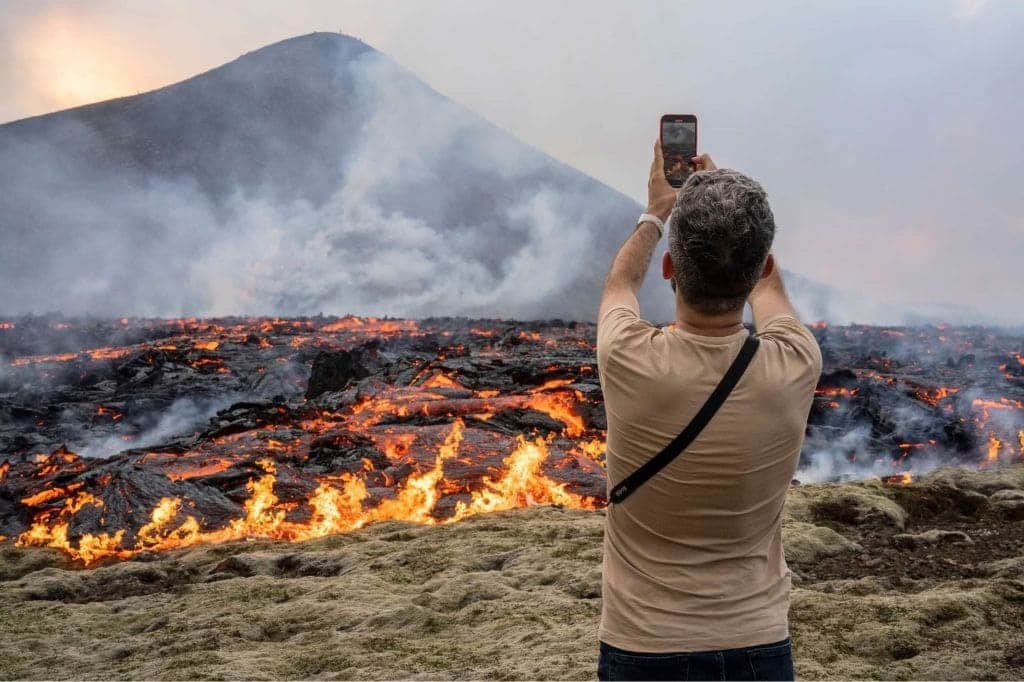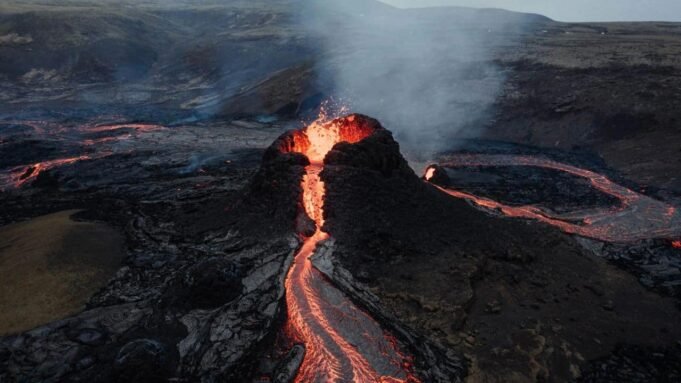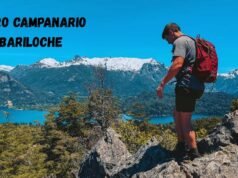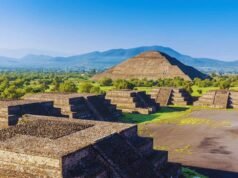Fagradalsfjall Volcano, located on Iceland’s Reykjanes Peninsula, captured global attention in 2021 when it erupted after lying dormant for nearly 800 years. Unlike explosive eruptions, Fagradalsfjall’s events have produced slow-moving lava flows that are both visually stunning and relatively accessible.
As one of Iceland’s most active volcanic sites in recent years, it has become a magnet for geologists, photographers, and curious travelers. Since 2021, multiple eruptions have transformed the landscape, offering a rare glimpse into the Earth’s inner forces in real-time. This article explores the volcano’s location, eruption history, current activity, and everything you need to know before planning a visit.
Where Is Fagradalsfjall Volcano Located?
Fagradalsfjall Volcano is situated on the Reykjanes Peninsula in southwest Iceland, about 40 kilometers from Reykjavik and just 20 kilometers from Keflavík International Airport. It lies within the active volcanic zone that stretches across the peninsula, where the North American and Eurasian tectonic plates meet.
The nearest town to the volcano is Grindavík, a coastal fishing village that often serves as a base for visitors. The volcano is accessible by marked hiking trails, with parking areas and trailheads located off Route 427 (Suðurstrandarvegur). Its proximity to major cities and roads makes it one of the most conveniently located active volcanoes in the world.
Is Fagradalsfjall Volcano Active?
Yes, Fagradalsfjall Volcano is currently considered active. Its first eruption in March 2021 marked the beginning of a new volcanic chapter for the Reykjanes Peninsula. Since then, the volcano has erupted again in 2022, 2023, and 2024, each time reshaping the landscape with fresh lava flows. The Icelandic Met Office closely monitors the area using seismic instruments, satellite imagery, and gas sensors.
While the volcano is not erupting at this exact moment, scientists report ongoing seismic activity and ground deformation—indicators of potential future eruptions. Visitors are advised to check daily updates from authorities before heading to the site.
Related: Iceland Volcano Eruptions
Eruption History
Ancient Dormancy
Before 2021, Fagradalsfjall Volcano had remained dormant for approximately 6,000 years, marking the 2021 eruption as a monumental geological reawakening.
2021 Eruption
On March 19, 2021, after a surge of seismic activity, the first eruption in centuries burst forth in the Geldingadalur valley. This effusive event produced dramatic lava fountains and spread lava across roughly 4.6 km² (1.8 mi²).
2022 and 2023 Activity
The region saw renewed activity:
- August 2022 saw a smaller but still notable eruption.
- 2023 brought a third eruption, continuing the geological surge that began in 2021.
These events collectively marked the beginning of what scientists now call the “New Reykjanes Fires” — echoing the medieval eruptions of 1210–1240.
2024 and 2025 Eruptions
After sustained activity, the volcanic focus shifted to the Sundhnúkur crater row:
- Multiple eruptions occurred through late 2024 and early 2025.
- On April 1, 2025, a new eruption began northeast of Grindavík, lasting briefly and drawing in visitors.
- The July 16, 2025, eruption marked the 12th event since 2021, with a 700–1,000 meter fissure near Stóra-Skógfell. Fortunately, no injuries were reported, and flights remained unaffected, though some evacuations and gas warnings were issued.
How to Visit Fagradalsfjall Volcano?
Reaching Fagradalsfjall is relatively easy thanks to its proximity to Reykjavik and well-developed trails. The main access points are via marked hiking routes starting near the town of Grindavík. The most popular trails—Meradalir and Langihryggur—offer different views of the eruption sites. Hikes range from moderate to challenging, with time estimates between 1.5 and 3 hours each way, depending on your chosen route and fitness level.
Wear waterproof hiking boots, windproof clothing, and layers suitable for Iceland’s rapidly changing weather. Bring water, snacks, a flashlight, and a fully charged phone. Travelers can choose between guided tours, which offer safety and geological insights, or solo hikes for more flexibility.
Read More: Exploring Rugged Trails
What to See at Fagradalsfjall Volcano?

Visitors to Fagradalsfjall Volcano are treated to an awe-inspiring display of nature’s raw power. You’ll encounter vast lava fields, steaming fissures, craters from recent eruptions, and hardened lava flows stretching across the valleys. The terrain offers an ever-changing canvas of black rock and vibrant mineral deposits.
Popular viewing spots allow for safe observation of cooled or active lava. Drone enthusiasts can capture dramatic aerial footage, but should follow local regulations strictly. Beyond the volcano, the Reykjanes Peninsula showcases moss-covered lava fields, geothermal vents, and panoramic ocean views—making the entire area a geological wonder worth exploring.
When Is the Best Time to Visit Fagradalsfjall?
The best time to visit Fagradalsfjall is during the summer months (June to August) when weather conditions are mild, daylight is plentiful, and hiking is safer. Spring and early autumn also offer good conditions with fewer crowds.
If the volcano is actively erupting, evening visits allow you to witness the glowing lava under dark skies—a truly unforgettable sight. To avoid crowds, plan your visit early in the morning or on weekdays. Always check weather forecasts and volcanic activity updates before heading out, as conditions can change rapidly in this dynamic environment.
What to Bring if You Want to Visit Fagradalsfjall?
If you’re planning a visit to Fagradalsfjall Volcano, it’s essential to come well-prepared for both safety and comfort. Start with sturdy hiking boots for navigating the uneven, often sharp volcanic terrain. Dress in layers, including a waterproof and windproof outer shell, as Icelandic weather can shift rapidly.
Bring gloves, a hat, and thermal clothing, especially if visiting outside summer months. Always carry plenty of water, high-energy snacks, and a fully charged phone—ideally with a portable power bank. A headlamp or flashlight is crucial for low-light conditions, and a gas mask or respirator may be recommended during active eruptions due to volcanic gases. Lastly, check local safety alerts and bring a map or GPS device, as trails may change with lava flows and new eruption sites.
Read Also: Fosslaug Hot Spring
Is It Safe to Visit Fagradalsfjall Volcano?
Visiting Fagradalsfjall Volcano can be safe—if you follow guidelines. The Icelandic authorities issue real-time alerts and advisories via the Icelandic Met Office (IMO) and the Department of Civil Protection. These updates inform visitors about seismic activity, weather hazards, and air quality. While the volcano’s eruptions are often non-explosive, risks remain. Volcanic gases like sulfur dioxide can be harmful, especially in low-lying areas.
Terrain is rough and sharp, with newly formed lava fields that may remain unstable. Always stay on marked trails, heed signage, and avoid closed zones. Guided tours further enhance safety through expert navigation and real-time hazard awareness.
Fagradalsfjall Volcano Facts & History
Fagradalsfjall Volcano is part of Iceland’s volcanic Reykjanes Peninsula, formed roughly 100,000 years ago. It had been dormant for around 800 years before erupting in March 2021. The eruption was triggered by tectonic activity where the North American and Eurasian plates diverge. Unlike Iceland’s more explosive volcanoes, Fagradalsfjall’s fissure eruptions produce steady lava flows, offering safer viewing opportunities.
Scientifically, the eruptions marked the start of a new volcanic cycle on the peninsula. Culturally, they reignited local interest in Iceland’s geology and drew worldwide fascination. The name “Fagradalsfjall” means “Beautiful Valley Mountain” in Icelandic—an apt description of its stunning setting.
Also Read: Scenic Hot Springs
Recent Eruptions and Their Impact
The volcano first erupted in March 2021, drawing thousands of visitors to witness the spectacle. Additional eruptions followed in August 2022, July 2023, and early 2024, each expanding the lava field and changing the landscape. These events boosted tourism significantly, especially for adventure travelers and volcanology enthusiasts.
However, nearby communities like Grindavík faced occasional evacuations and road closures. While the environment was reshaped, the slow lava flows limited widespread destruction. Scientists gained valuable data on fissure eruptions and mantle dynamics, using the eruptions as a live laboratory. Fagradalsfjall remains one of the most closely studied volcanoes in modern times.
Tips for Photographing the Volcano
Photographing Fagradalsfjall offers a once-in-a-lifetime opportunity to capture nature’s raw energy. For the best shots, visit during sunrise or sunset, when soft lighting enhances the textures of the lava and the surrounding landscape. At night, glowing lava stands out dramatically against the dark sky, but you’ll need a tripod and longer exposure settings.
Bring a DSLR or mirrorless camera with a wide-angle lens, extra batteries, and weather protection. Drones are allowed, but must follow Icelandic aviation rules—stay below 120 meters and avoid flying near crowds or emergency teams. For safety, always keep a respectful distance from lava, stay on trails, and watch your footing while composing shots.
Nearby Attractions and What Else to Do
While Fagradalsfjall is a highlight, the surrounding Reykjanes Peninsula offers plenty more to explore. Relax at the Blue Lagoon, Iceland’s most famous geothermal spa, located just a short drive away. Visit the Reykjanes Lighthouse, the country’s oldest lighthouse, perched dramatically above the ocean cliffs.
Walk across the Bridge Between Continents, a symbolic footbridge linking the Eurasian and North American tectonic plates. If you’re venturing further south, consider stopping at the Icelandic Lava Show in Vik, which provides an indoor demonstration of real lava in a safe setting. Together, these sites create a well-rounded adventure in Iceland’s fiery frontier.
Read More: Blue Heart Springs
Frequently Asked Questions (FAQs)
Can you hike to Fagradalsfjall without a guide?
Yes, you can hike to Fagradalsfjall independently via marked trails, but be sure to check weather and activity updates before setting out. Guided tours are recommended for added safety and insights.
Is Fagradalsfjall erupting right now?
The volcano is not erupting at this moment, but activity can resume with little warning. Check the Icelandic Met Office for real-time updates before visiting.
How far is the volcano from Reykjavik?
Fagradalsfjall Volcano is approximately 40 km (25 miles) from Reykjavik, or about a 45-minute drive. It’s also just 20 km from Keflavík International Airport.
What’s the difference between Fagradalsfjall and other Icelandic volcanoes?
Unlike more explosive Icelandic volcanoes like Eyjafjallajökull, Fagradalsfjall Volcano produces slow-moving lava from fissure eruptions, making it safer and more visually accessible for visitors.
Do I need special gear to visit?
No technical gear is required, but sturdy hiking boots, warm layers, waterproof clothing, and a flashlight or headlamp are essential for a safe and comfortable hike.
Conclusion
Fagradalsfjall Volcano offers a rare opportunity to witness Earth’s dynamic forces in action, making it one of Iceland’s most exciting natural attractions. Its accessible location, stunning lava fields, and recent eruptions have transformed the site into a must-visit destination for nature lovers and adventure seekers alike. As you plan your visit, prioritize safety—check volcanic activity reports, follow marked trails, and be prepared for changing weather. By traveling responsibly and staying informed, you’ll not only have a memorable experience but also help preserve this unique volcanic landscape for future explorers.















